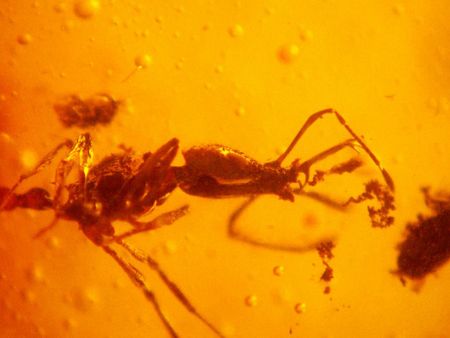Acanthognathus poinari
| †Acanthognathus poinari Temporal range: Burdigalian, Early Miocene Dominican amber, Dominican Republic | |
|---|---|

| |
| Scientific classification | |
| Kingdom: | Animalia |
| Phylum: | Arthropoda |
| Class: | Insecta |
| Order: | Hymenoptera |
| Family: | Formicidae |
| Subfamily: | Myrmicinae |
| Tribe: | Attini |
| Genus: | Acanthognathus |
| Species: | †A. poinari |
| Binomial name | |
| †Acanthognathus poinari Baroni Urbani, 1994 | |
Acanthognathus poinari is the only fossil species known from Acanthognathus and appears to be one of the most morphologically specialized species within the genus.
Photo Gallery
Identification
An Acanthognathus species distinguishable from all other known ones for the transverse rugulation on the posterior cephalic angles. At first glance, A. poinari appears most closely related to Acanthognathus brevicornis (Panama to Rio Grande do Sul in Brazil) or Acanthognathus teledectus (Costa Rica and Colombia), two species with which it shares a relatively smooth integument.
Distribution
This taxon was described from Dominican amber, Dominican Republic (Burdigalian, Early Miocene).
Castes
Nomenclature
The following information is derived from Barry Bolton's Online Catalogue of the Ants of the World.
- †poinari. †Acanthognathus poinari Baroni Urbani, in Baroni Urbani & De Andrade, 1994: 41, figs. 20, 21, 26, 27 (q.) DOMINICAN AMBER (Dominican Republic, Miocene).
- Status as species: Bolton, 1995b: 53; Bolton, 2000: 17; Galvis & Fernández, 2009: 248 (in key).
Description
Head (Fig. 27) elongate, with nearly straight sides gradually converging anteriorly, feebly emarginate occipital border and angulate posterior cor ners. Compound eyes oval, slightly protruding and situated in the middle of the head sides. Anterior border of clypeus irregularly rounded and only feebly protruding. Scapes and mandibles shorter than head length. Antennae with clearly two-jointed club.
Trunk short and globose, with a flat dorsal plane constituted by part of the meso and metanotum; the latter descending abruptly posteriorly in profile. Propodeal spines pointed, relatively short, directed upwards. Propodeal declivity only slightly concave. Petiole three times longer than broad, with a long anterior peduncle and rounded node in profile. Postpetiole slightly longer than broad with comparably rounded node. Gaster round in dorsal view.
Wings: fore wings with marked pterostigma and R+Sc, traces of M +CuA and 2r. Other veins partially or completely indistinguishable. Hind wings only with a long portion of M +CuA clearly visible.
Sculpture: dense, deep polygonal fossae diminishing in density and deep from the genae towards the vertex; the vertex proper with transverse striae continuing longitudinally over the posterior half of the sides of the head and on its ventral face. Trunk very slightly longitudinally striate and with effaced fossae. Petiole and postpetiole covered by feeble, longitudinal striae, partly effaced on the petiolar node and completely so on the postpetiolar one. Posterior borders of the first and second gastral segments with longitudinal costulations. Rest of the body smooth or slightly punctate only.
Pilosity: sparse, short, pointed, suberect or erect hairs on the dorsum of the head. Similar, slightly longer hairs on the trunk and abdominal peduncle. Scape, mandibles and legs with rare, sparse hairs slightly shorter than those on the head, pointed and semi-decumbent. Dense, very short, pointed and decumbent hairs on the funicular joints, much sparser on the gaster.
Colour reddish-brown, shining, with slightly lighter antennae and legs.
References
- Baroni Urbani, C. 1994c. [Untitled. Acanthognathus poinari Baroni Urbani n. sp.] Pp. 41-44 in: Baroni Urbani, C., De Andrade, M. L. First description of fossil Dacetini ants with a critical analysis of the current classification of the tribe (Amber Coll (page 41, figs. 20, 21, 26, 27 queen described)
- Baroni Urbani, C.; De Andrade, M. L. 1994. First description of fossil Dacetini ants with a critical analysis of the current classification of the tribe (Amber Collection Stuttgart: Hymenoptera, Formicidae. VI: Dacetini). Stuttg. Beitr. Naturkd. Ser. B (Geol. Paläontol.) 198: 1-65.( (page 41, figs. 20, 21, 26, 27 queen described)
- Bolton, B. 1995b. A new general catalogue of the ants of the world. Cambridge, Mass.: Harvard University Press, 504 pp. (page 53, catalogue)
- Bolton, B. 2000. The ant tribe Dacetini. Mem. Am. Entomol. Inst. 65: 1-1028 (page 17, see also)
- Jacintho, G.de F., Vieira, E.M.de A., Teixeira, G.A., Lopes, D.M., Serrão, J.E. 2024. First karyotype description for Acanthognathus rudis Brown & Kempf, 1969 (Formicidae: Myrmicinae) with notes on its natural history. Sociobiology 71(3), e10778 (doi:10.13102/sociobiology.v71i3.10778).

